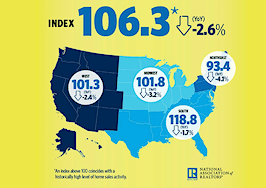Bad news for the housing market from the National Association of Realtors this morning. NAR’s Pending Home Sales Index was 106.0 for the month of September, the same as August. That’s down 3.5 percent from last year. And perhaps more worryingly, it’s also the fifth month to see declines in the past six.
The index is now at its lowest reading in nearly three years since it hit 104.7 in January 2015.

“Demand exceeds supply in most markets, which is keeping price growth high and essentially eliminating any savings buyers would realize from the decline in mortgage rates from earlier this year,” said NAR Chief Economist Lawrence Yun. “While most of the country, except for the South, did see minor gains in contract signings last month, activity is falling further behind last year’s pace because new listings aren’t keeping up with what’s being sold.”
Yun says Hurricanes Irma and Harvey are to blame for the South’s 2.3 percentage point decline in September.
“Hurricane Irma’s direct hit on Florida weighed on activity in the South, but similar to how Houston has rebounded after Hurricane Harvey, Florida’s strong job and population growth should guide sales back to their pre-storm pace fairly quickly,” he added.
Lastly, Yun says he expects the pending homes sales to continue to slide in the coming months, thanks to the annual decline in inventory during the winter months.
“Buyers looking for a little relief from the stiff competition from over the summer may, unfortunately, be out of luck in the coming months,” he said. “Inventory starts to decline heading into the winter, and many would-be buyers from earlier in the year are still on the hunt to find a home.”
Regional breakdown
- Northeast: The pending sales index rose 1.2 percent to 94.5 in September, 2.4 percent below a year ago.
- Midwest: The index increased 1.4 percent to 102.9, a 2.5 percent drop from September 2016.
- South: The index dropped 2.3 percent to 115.9, a 5.0 percent year-over-year decrease.
- West: The index increased 1.9 percent to 102.7, down 2.9 percent year over year.
NAR uses a large national sample of signed residential property sale contracts to build its monthly pending home sales index. The sample size typically represents about 20 percent of transactions for existing-home sales.
The index level was benchmarked to 100 in 2001, which was the first year to be examined. Existing-home sales in 2001 were in the 5 million to 5.5 million range, which is considered normal for the population in the U.S.











